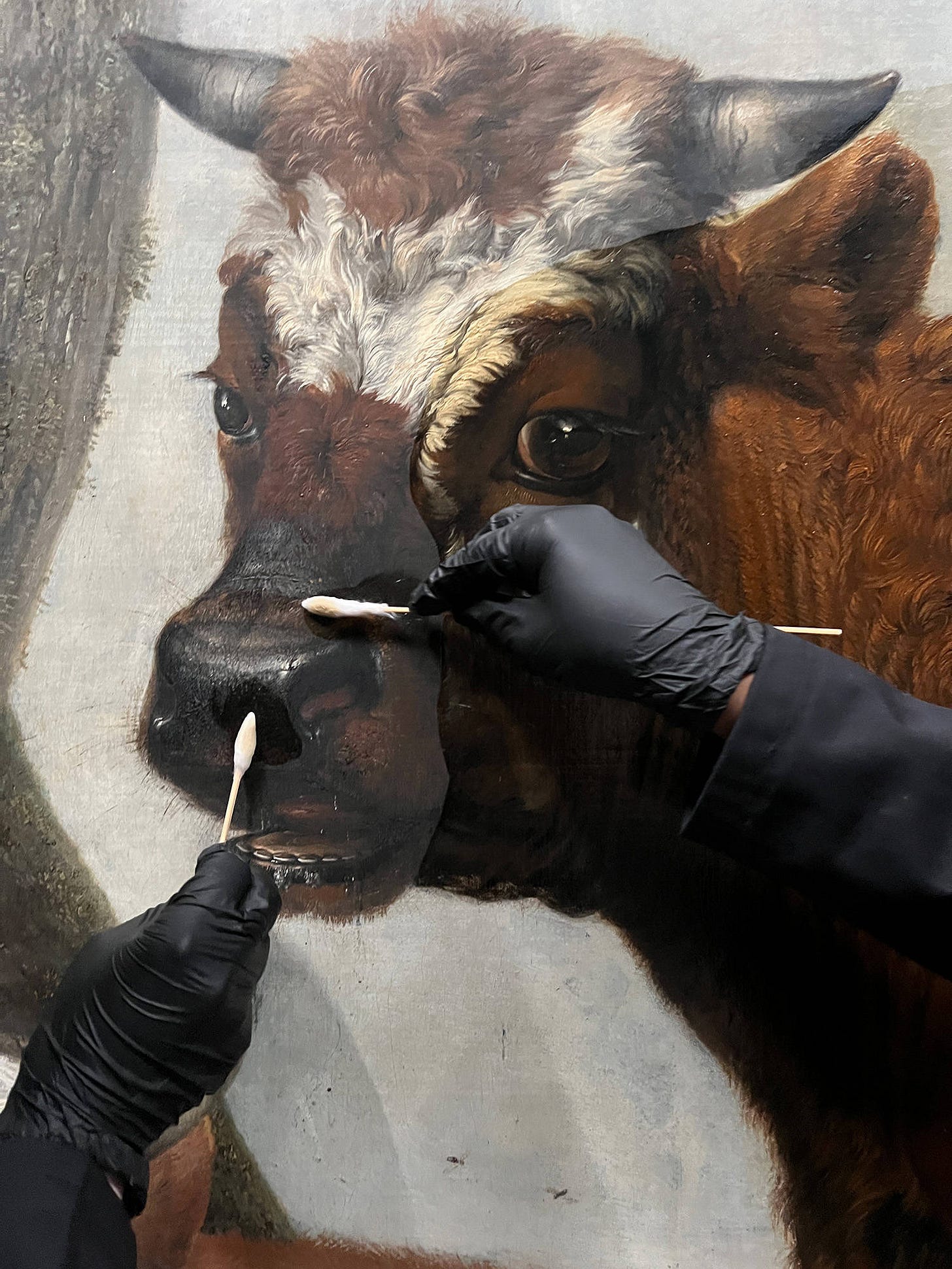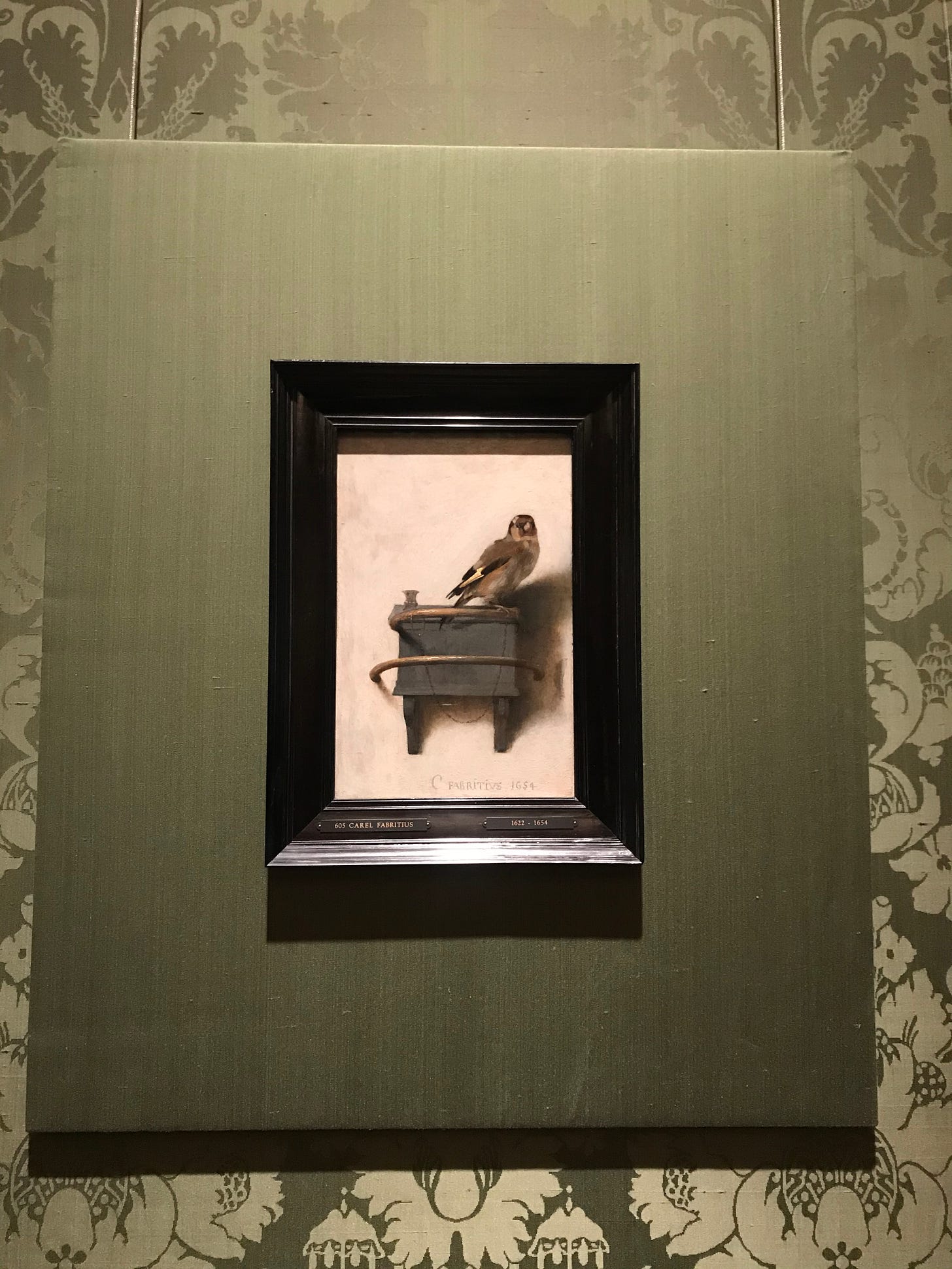welcome! before we begin: cloudtopia looks best viewed in a browser. if you received this newsletter as an email, you may need to open it elsewhere to read to the end!
this newsletter is part of a mini series on art museums, museum going, and the relationships between viewer and art that unfold in experiential spaces.
the museum gazes back
the art museum as panopticon, nijntje/miffy as a modern dutch art icon, Las Meninas, Saturn Devouring his Son, and paintings that are also puzzles.
who watches the night watch?
on Rembrandt, Vermeer, and the art museum experience of watching and being watched.
in “the museum gazes back”, we virtually visited the Museo del Prado in Madrid, while in "who watches the night watch?” we took a digital tour of one of the best galleries of the Amsterdam Rijksmuseum. This week, we’re back in the Netherlands, this time visiting the Hague and a lesser known but incredible museum: Mauritshuis.
In this piece, we’ll be thinking about questions of legacy and how museum spaces reconcile the images and ideas of the past with the world of the present.
Mauritshuis
In the town of the Hague(den Haag), a beautiful mansion formerly home to Prince Johan Maurits1 has become an art museum that hosts several masterworks of dutch art, including Rembrandt’s The Anatomy Lesson and Vermeer’s Girl with a Pearl Earring. Although Mauritshuis as a place has become far more than just the former home of Maurits, his history still haunts the house today.
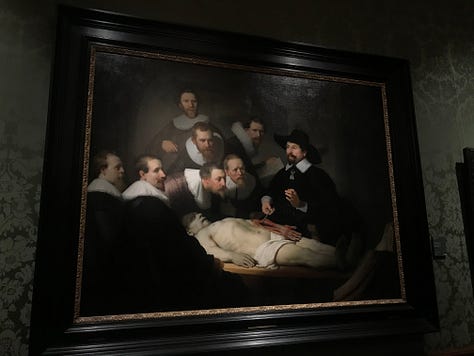

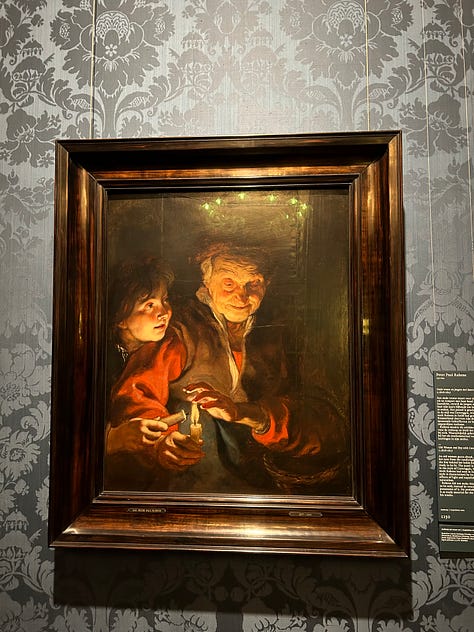
Maurits was governor of the colony of Dutch Brazil from 1636 to , and his role in the imperial project of the colony, including the slave trade, is a significant part of his legacy. Much of his fortune was made from his involvement in slave trading, and he was himself a slave owner, which permitted Maurits to build his house in the Netherlands along with his art collection. Mauritshuis today still stands on the foundation of this shameful colonial history.
Until recently, the museum displayed a statue of Johan Maurits, and for a long time he was represented and regarded generally positively as a patron of the arts and the founder of an important museum space. But in the 2010s, interest in the figure of Maurits and Dutch colonial history inspired new research and a re evaluation of his legacy, and an exhibition in 2019 presented new perspectives on this history, with a surge of new research being done in the following years and efforts to retell the history of Maurits and Mauritshuis as an institution being taken up by the museum.
Today, they display informational texts about the history of the house, its namesake, and the history of the sugar plantations of Dutch Brazil and the use of slave labour to keep the sugar trade running, as well as Maurits extensive involvement in promoting slavery and the slave trade in this region during his governorship. The museum’s site also features a page on Maurits, which shares this history and discusses the importance of recognising the historic injustices that shaped the institution and the imperial legacy of figures like Maurits, whose evils have long been overlooked in the historical record.
art & education
But the increasingly comprehensive story the museum now shares about Maurits is only one of many ways that they are working to educate the public and share important and interesting histories.
Throughout this series, I’ve been really delighted to find that so many of the museums we are discussing offer digital tours, digitised catalogues, and other forms of sharing art and information online, and so have made an effort to share those resources so that readers can engage with museum collections and spaces in different ways. I am especially impressed with the educational resources, articles, and stories shared on the Mauritshuis website to make art, art history, and the museum experience of their collection accessible world wide.
If you want to read more about the collection, view images, and learn about a wide range of art and art historical topics, this website is a great place for it. A few recommendations:
Rembrandt - offers interesting insights into the work of Rembrandt van Rijn, (who we discussed previously in this series when looking at iconic painting like The Night Watch), and explores several of his works hosted in the museum’s collection.
Also of interest is this special exploration of several works previously attributed to Rembrandt, but which have recently been re evaluated. The research process of figuring out the mystery behind these works is laid out in this article and tells a very interesting story about the process of evaluating, producing, and restoring art, both in Rembrandt’s time and in our own.
Animals at the Mauritshuis - an interactive tour focusing on images of animals, designed to be accessible to younger audiences.
Race Against Time is another fantastic digital exhibit on restoration and conservation of paintings, presented by three of the conservators who work at Mauritshuis and help to take care of its painting collection. This includes video, images, text, and interactive elements, and features several of the paintings recently given “facelifts and makeovers” by the conservation team.
The Bull is among those paintings currently being restored at Mauritshuis, and is also one of the museum’s most iconic works. During a visit to Mauritshuis last summer, I got to see a glimpse of this painting while it was in early stages in the restoration studio there, and I really enjoyed learning more about the painting itself and the processes that are being undertaken to do further research into The Bull and conserve it for the next generation of museum goers.
iconic images: the gold finch and the pearl earring
It’s hard when visiting an art museum not to go in with specific expectations. When we go in, we want to see the hits. We go to the Louvre to see the Mona Lisa, or to MOMA to see The Starry Night. I am no stranger to this phenomenon: when I go to a museum, I want to see the best they have to offer. I want to see paintings that I know from Animal Crossing. I want to see the hits!
Museums thrive on reputation, and it is common practice to advertise specific well known works of art to encourage and guide visitors to a museum. Museum maps today often indicate to viewers which works are most famous and worth seeing, making the sometimes overwhelming or inaccessible collections easier to navigate for the average visitor, in particular tourists who will make up a large number of museum visitors and often have limited time.
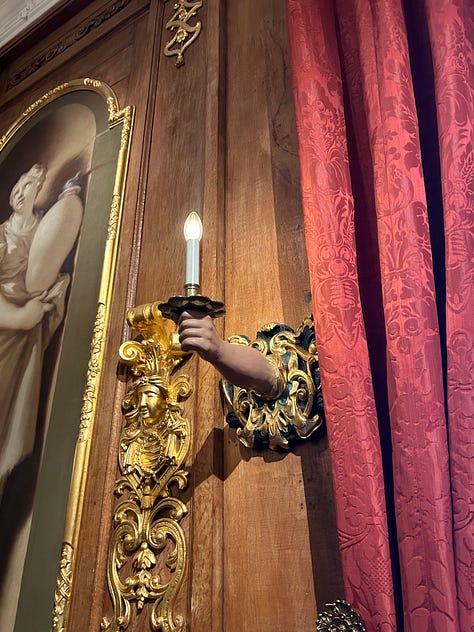
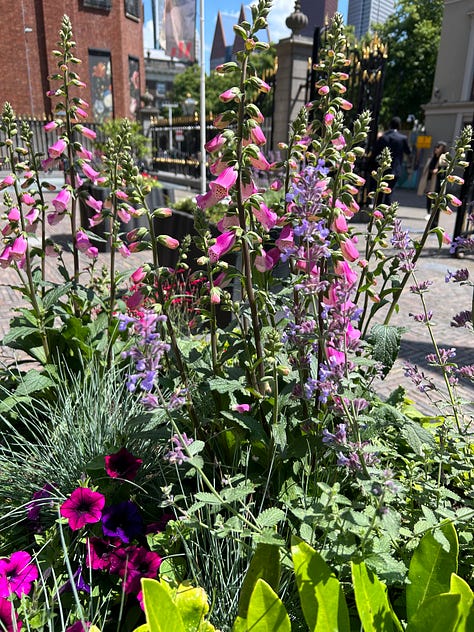
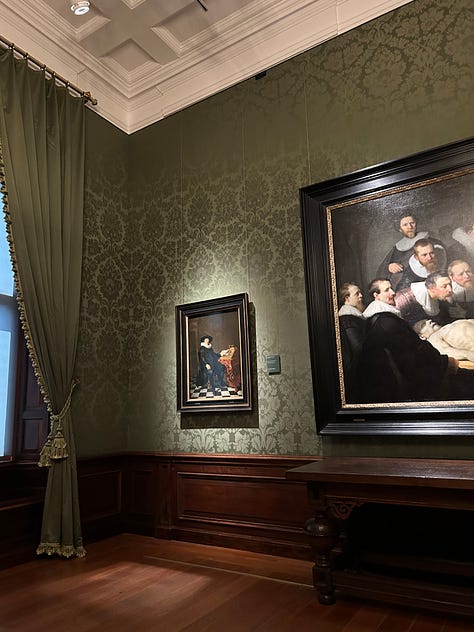
When visiting the Mauritshuis, there were two hit works I was especially excited to see: The Goldfinch by Carel Fabritius, and Girl with the Pearl Earring by Johannes Vermeer(the latter is the more famous of the two, and arguably the most well known work in the museum’s collection today).
the goldfinch
Made famous to me by the Donna Tartt novel of the same name, The Goldfinch is a small but incredibly beautiful work depicting a European Goldfinch tethered by a thin, fragile chain to its perch.2 The artist, Carel Fabritius is an interesting figure of 17th century Dutch art, who studied art at the studio of Rembrandt in Amsterdam and later was a leading figure of the Delft School. We can trace his history between those of Rembrandt, of whose studio Fabritius was one of the most promising students, and Vermeer, a fellow Delft artist who was inspired by Fabritius’ work. (Both of these artists’ legacies have eclipsed that of Fabritius.) He died unexpectedly at a young age in the Delft explosion of 1654, which also destroyed his studio and much of his work.
In Donna Tartt’s novel, the painting is featured in an exhibition at the Metropolitan Museum of Art in New York, where the young protagonist Theodore Decker first encounters the painting, and then in the panic of an explosion in the museum, steals it. The painting, hidden under layers of newspaper follows him as he grows up and moves through the worlds of wealthy Park Avenue families in post 9/11 New York City to the lonely desertscapes of suburban Las Vegas, to, year later, the canals of Amsterdam. The novel is a densely packed epic that follows Theo through the trials and trauma of his adolescence and early adulthood, but it is also an insightful work that considers the stories we tell through art and objects, the darkness (and light) of the art world, and the staying power and legacy of beautiful objects.
The bird in the painting seems almost to be alive, like it might hop or flap its wings at any moment. It is painted to scale, and the soft texture of its feathers, the shadows on the wall, and other details render it hauntingly life-like. In The Goldfinch, Tartt writes that “between ‘reality’ on the one hand, and the point where the mind strikes reality, there’s a middle zone, a rainbow edge where beauty comes into being, where two very different surfaces mingle and blur to provide what life does now: and this is the space where all art exists, and all magic.”3 Or, as Morri Creech writes in the poem “Goldfinch”:
“The bird is fiction though the paint is real … You stare
from a modest trompe l’oeil heaven we don’t share.”4
Viewing the painting in person, face to face with heaven, I found its magic undeniable.
Interestingly, although the painting remains a popular work, and Tartt’s novel is a staple of the Mauritshuis gift shop, in my experiences in the gallery the painting does not seem to draw much of a crowd. Many visitors give it a glance and walk past it to view larger or more interesting works. For me, this is a dream come true, because it means I can spend as much time with it as I want, and get close, which is not the case with other works on display here — we’ll come back to this shortly.
In a journal entry at the end of The Goldfinch, Theo Decker writes:
“it is a glory and a privilege to love what Death doesn’t touch. For if disaster and oblivion have followed this painting down through time—so too has love. Insofar as it is immortal(and it is) I have a small, bright, immutable part in that immortality. It exists; and it keeps on existing. And I add my own love to the history of people who have loved beautiful things, and looked out for them, and pulled them from the fire, and tried to preserve them…”5
In this story we see so many stories about art: the real story of Carel Fabritius, his life and death, the fictional account of Tartt’s novel, stories of art theft and recovery, the stories of the restoration work being done by teams of conservators at Mauritshuis and beyond, the stories of museumgoers who view and experience art, and the stories of art lovers everywhere. In real life, The Goldfinch was never displayed at the Met, never stolen. But it is one of the few lasting pieces of Fabritius’ legacy, so much of which is lost to time and tragedy. It remains an achingly moving work that, if no other, tells the story of a little bird who cannot fly away. And for everyone who views it and experiences its fragile beauty, these stories goes on.
the girl
At Mauritshuis, the iconic Girl With a Pearl Earring remains the greatest draw.

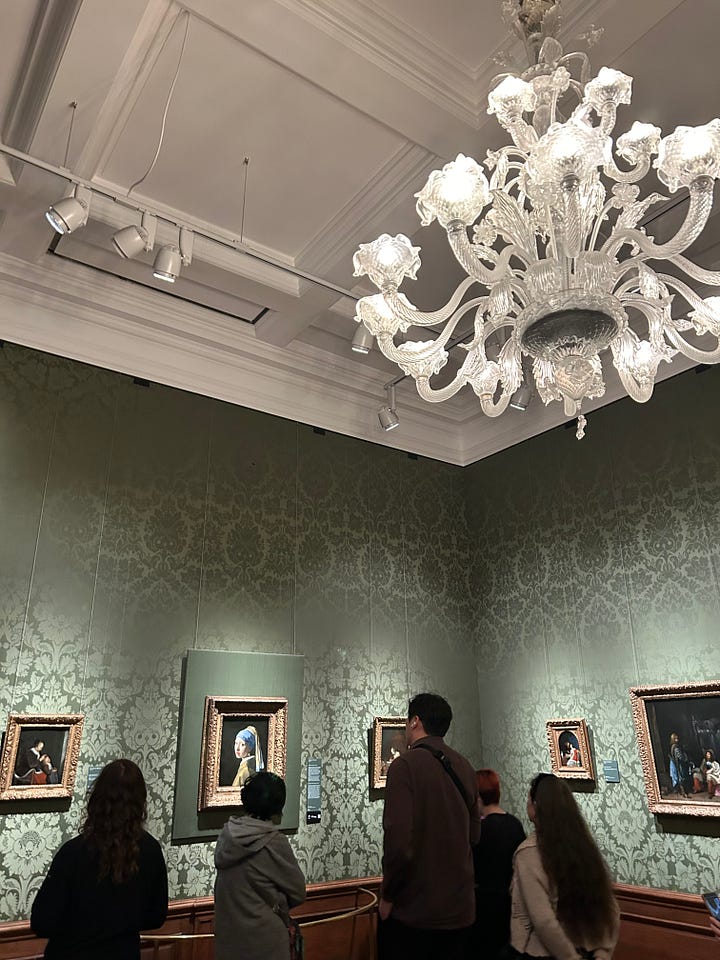
When everyone wants to see a famous painting like this one, crowds can make it difficult to view or engage with it, while other works go unnoticed. This is common at most major museums, and is in many ways encouraged by the way museums advertise themselves and their most famous, reproduced images. This serves a purpose, certainly, but it can often be a limiting factor on the museum experience and the viewer’s capacity to engage with the art. The flow and experience of museum spaces is disrupted.
Are we really experiencing a great work of art when we take only the time to photograph it before moving on? Can a work of art become too famous for its own good, on display only to be a background for tourist’s selfies, to promote museum merch and endless reproductions?
From “The Most Famous Girl in the World”:
People travel to The Hague from all over the world to see Johannes Vermeer’s Girl with a Pearl Earring in the flesh. Or dream of coming here. They buy posters, fridge magnets and socks bearing her image. They set her as the desktop image on their computer, watch the film with Scarlett Johansson and read Tracy Chevalier’s novel. Or they dress up as the Girl.6
The room where Girl With a Pearl Earring is displayed is filled with paintings, but they are largely overlooked in favour of Vermeer’s imagined portrait(also known as a tronie); drawn to the illusory lighting of the image and the piercing, mysterious gaze of the girl who looks back at the viewer.
I find that the room is usually occupied by people photographing the painting. Groups gather in front of it to take selfies, blocking it from view to ensure they have the perfect background for their holiday photos. I find this kind of museum-going somewhat disruptive, and honestly just kind of exhausting. I hate having to fight against crowds of people taking pictures in front of the painting and how difficult it can make navigating the space and getting any opportunity to see a work without the mediation of dozens of cell phone cameras obstructing the view. I tend to think of this as ‘the Mona Lisa effect’, where the photo of the image is more important than the image itself, as is often seen in the Louvre where, instead of putting the renowned da Vinci painting on display in an ordinary gallery, the museum forces visitors to wait in a special queue to get a brief moment to stand in front of the Mona Lisa and photograph it.
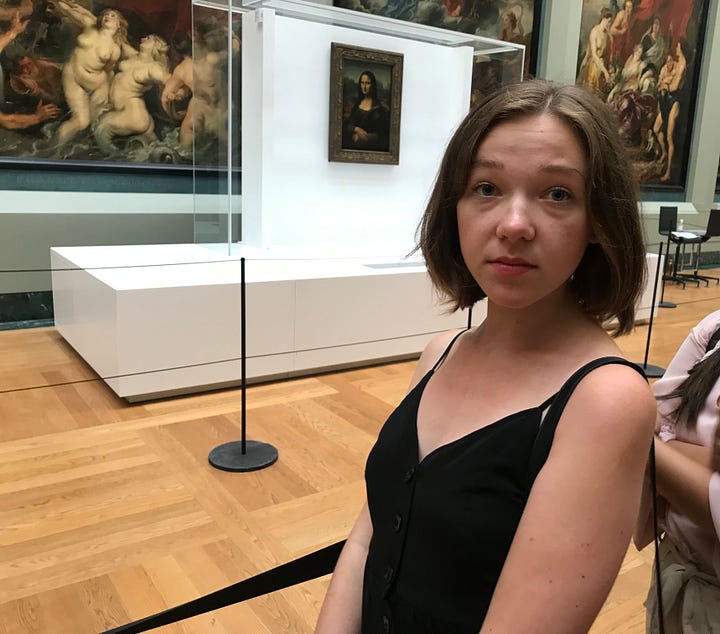
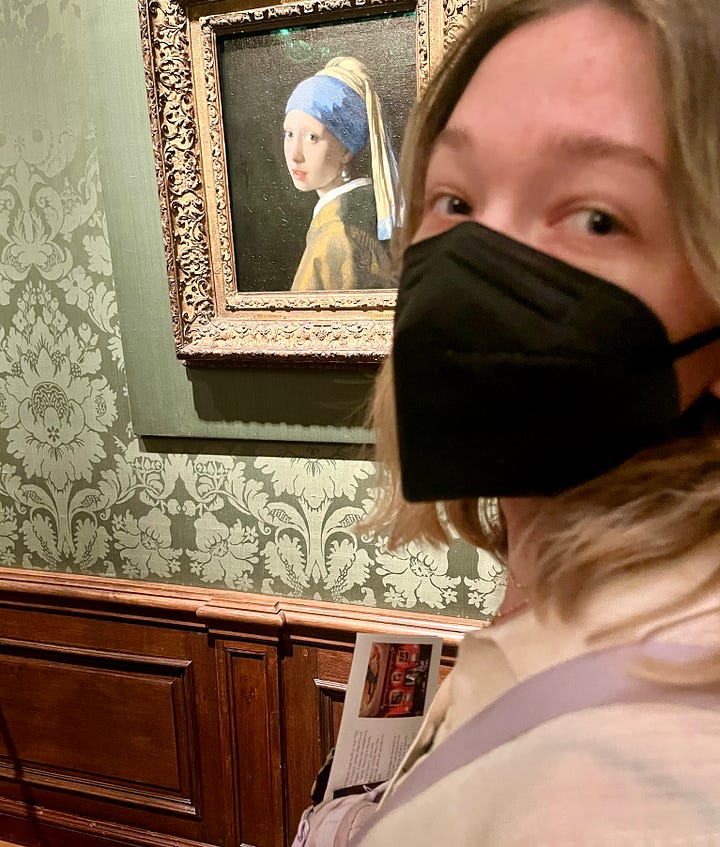
In saying all this, though, what right do I have to dictate how people should experience art? What counts as the ‘good’ or ‘correct’ way to engage? After all, I too love taking photos in museums(although I always try to do so quickly). I love museum shops. Who am I to say that the selfie takers aren’t getting as much out of great works of art as I think I am?
What right does anyone have to decide what counts?
In previous newsletters in this series, I’ve talked about the idea of surveillance and policing in museum spaces, and the way that these institutions work to control visitor experience and behaviour at many levels. In some museums, this extends to things like photography. Often, these forms of institutional control serve to exclude some viewers, and to reassert specific understandings of the museum, the histories they tell, aesthetic standards, and hegemonic, overwhelmingly western cultural values.
Museums are spaces that replicate and enforce hierarchical and harmful social structures, institutions of empire7 and capitalism built on the wealth of enslavers(Johan Maurits being one) and industrialists(like J. Paul Getty), and european colonial powers(many, many others). The museum gaze is cold, reminding us that we do not measure up to the standard, that empires never really fall, that history is told by the victors.
And yet, I still believe in the museum. These places also are essential spaces of cultural reproduction and exploration, preserving history and objects from our past, doing incredible research work, making art and history accessible, and sharing the knowledge and experiences and magic of art. The museum gaze invites us into mystery, a window into the past framed in ornate carvings. Communion with the dead, a glimpse of immortality.
The questions of experience and the ways we engage with art in the museum space are endlessly contestable and complex. We walk through halls built by evil deeds, filled with haunted and haunting legacies of the past, to seek out beauty and magic. We reproduce and restore and retell the stories of past worlds. The art lives on.
tot ziens,
isobel
Maurits is known internationally as John Maurice.
For more information and images of this painting, you can visit the Mauritshuis site page dedicated to The Goldfinch.
Donna Tartt, The Goldfinch, digital edition, 2013, page 770.
Morri Creech, “Goldfinch”, First Things, 2010.
Tartt, 770-771.
Abbie Vandivere, Janice Deul, and Tracy Chevalier. “The most famous girl in the world.” Mauritshuis.
See also: https://www.mauritshuis.nl/en/our-collection/artworks/670-girl-with-a-pearl-earring for more details
For more thought on this, (focused more on the context of historical objects/museums rather than art), see also: The Museum Will Not Be Decolonised
“Museums are not neutral in their preservation of history. In fact, arguably, they are sites of forgetfulness and fantasy. The way exhibitions are constructed usually assumes a white audience and privileges the white gaze. The white walls signified the choices of white people, their agency, their museum collections, and the endeavours of colonialists.”
Sumaya Kassim, “The Museum Will Not Be Decolonised” Media Diversified, 2017.






